
North Face Vs Mammut (The Definitive Guide)
By Unlock Wilderness
5th June 2023
Are you an adventure seeker in search of the perfect coat or jacket? Look no further, because we've got you covered. Today, we're comparing two of the biggest names in outdoor apparel: North Face and Mammut. Both brands are known for their top-tier performance and durability, but which one reigns supreme?
From materials to design, we'll break down the key differences and similarities so you can make an informed decision for your next outdoor excursion. So, grab a cup of hot cocoa, cozy up, and let's dig in!
Men's Lightweight Insulated Jackets
Women's Lightweight Insulated Jackets
This post contains affiliate links; as an Amazon Associate we earn commission from qualifying purchases.
North Face Vs Mammut
Brand Overview
When it comes to outdoor gear, North Face and Mammut are two of the most well-known and respected brands in the industry. Let's start with North Face, which was founded in 1966 in San Francisco by two hiking enthusiasts. Since then, it has become one of the most recognized brands in the world of outdoor apparel and gear.
North Face has built a reputation for producing high-quality gear that can withstand even the harshest environments. Their products are designed for adventurers who want gear that is rugged, durable, and reliable. North Face is also committed to sustainability, using recycled materials in their gear and participating in initiatives to reduce their environmental impact.
On the other hand, Mammut is a Swiss company that has been around for over 150 years. Originally, they made rope for climbers, but they've since expanded to produce a wide range of outdoor gear. Mammut is known for their commitment to safety, with their products designed to protect outdoor enthusiasts in all kinds of weather conditions.
Mammut is also committed to sustainability, using eco-friendly materials like recycled polyester and organic cotton in their gear. They even have a program called "Mammut Cares" that promotes responsible production and ethical working conditions.
Overall, both North Face and Mammut are well-respected brands with a long history of producing high-quality outdoor gear. Whether you're a seasoned adventurer or just starting out, you can't go wrong with either of these brands. We hope this overview has helped you understand the values and reputation of both North Face and Mammut, so you can make an informed decision when choosing your outdoor gear.
Warmth and Insulation
When you're out and about in chilly weather, it's important to have a coat or jacket that can keep you warm. That's why the warmth and insulation of a product is a crucial factor to consider when choosing between North Face and Mammut.
Both brands offer a range of materials for their coats and jackets, including down, synthetic insulation, and fleece. North Face's signature insulation is their ThermoBall technology, which uses synthetic fibers to mimic the insulating properties of down while remaining lightweight and water-resistant. Meanwhile, Mammut uses their own proprietary synthetic insulation called Ajungilak. This technology is designed to provide warmth even in extreme conditions and uses recycled materials for an eco-friendly touch.
When it comes to materials for colder temperatures, North Face offers their HyVent membrane that is designed to keep you dry and warm in even the harshest conditions. Additionally, some of their jackets come with a Gore-Tex shell, which is known for its exceptional insulation capabilities.
On the other hand, Mammut uses Mammut Dry Technology to protect users from moisture while also providing excellent warmth retention. The outer layer is designed to be highly breathable to help regulate your body temperature, keeping you warm but not too hot.
Overall, both brands have a proven track record of providing warm and insulated jackets that can stand up to tough conditions. It ultimately comes down to individual preference, with each offering their own unique take on warmth and insulation. When choosing between North Face and Mammut, consider the materials, insulation technology, and intended use to determine the best fit for your needs.
Durability and Quality
When it comes to outdoor gear and apparel, durability and quality are essential. No one wants to spend their hard-earned cash on a coat or jacket that's going to fall apart after a season of use. That's why we're taking a closer look at North Face and Mammut's offerings in terms of durability and quality.
First, let's talk materials. North Face uses a variety of high-quality materials, from Gore-Tex to their own proprietary materials like HyVent and DryVent. Mammut, on the other hand, sticks mainly to Gore-Tex. While Gore-Tex is a trusted waterproof and breathable material, some people feel that variety is important when it comes to outdoor gear.
Next, let's talk construction. Both North Face and Mammut use superior construction techniques, like sealed seams, reinforced stitching, and taped zippers. However, North Face tends to have a wider variety of construction techniques in their products. For example, their jackets may have different types of insulation depending on the model, while Mammut usually sticks to down.
Finally, let's consider overall workmanship. Both North Face and Mammut are known for their high-quality workmanship. However, North Face has been in the game longer and has had more time to perfect their craft. That being said, Mammut is a highly respected brand in the outdoor industry and their workmanship is of top-notch quality.
In conclusion, in terms of durability and quality, both North Face and Mammut are excellent choices. While North Face offers more variety in terms of materials and construction, Mammut's focus on Gore-Tex and down insulation is tried and true. Ultimately, the best choice will depend on your personal preferences and the type of outdoor activities you plan to engage in.
Style and Fashion
When it comes to choosing the right outdoor gear, many buyers consider more than just its performance capabilities. Style and fashion are becoming increasingly important factors for those looking to make a statement with their outdoor clothing.
So, how do North Face and Mammut compare in terms of their style and fashion offerings?
Well, North Face is known for their classic and timeless designs that appeal to a wide range of consumers. Their jackets, for instance, often come in neutral colors such as black, brown, and grey, making them versatile and easy to pair with any outfit. However, they have started offering some bolder options such as bright blues and reds for those who want to stand out.
On the other hand, Mammut is a brand that prides itself on their quirky and distinctive style. They offer more unique color options such as neon green and turquoise, perfect for those who want to make a fashion statement in the great outdoors. They also have a range of designs that feature distinct geometric patterns and textures that make their products stand out.
Choosing between North Face and Mammut ultimately comes down to personal style preferences. North Face is great for those who prefer classic looks with a refined touch, while Mammut is perfect for fashion-forward outdoor enthusiasts who want to try something a little different.
Regardless of which brand you choose, both North Face and Mammut offer high-quality and durable products that will keep you warm and protected in any weather condition. So why not choose a design that speaks to your personality and makes you feel good while you're exploring the great outdoors?
North Face Vs Mammut Men's Down Jackets
Both North Face and Mammut offer a wide range of Men's Down Jackets, but they differ in their approach to design and materials. The North Face's 1996 Retro Nuptse Jacket features 100% recycled fabrics and a non-PFC DWR finish, making it an eco-friendly and practical choice for everyday outdoor activities. Meanwhile, Mammut's Eigerjoch Pro IN Hooded Jacket is designed for extreme cold conditions, with an ultra-light and abrasion-resistant Pertex® Quantum Pro material, water-repellent down treated with PrimaLoft™ synthetic fiber insulation, and partially taped seams to keep you warm and dry in the toughest environments. If you're looking for a more versatile jacket that you can use on a daily basis, The North Face may be the better choice. However, if you're planning to go on a mountain expedition or engage in cold-weather outdoor activities, Mammut's Eigerjoch Pro IN Hooded Jacket is definitely worth considering. Ultimately, the choice between the two brands comes down to your individual needs and preferences, but both offer excellent quality and functionality in their Men's Down Jacket collections.
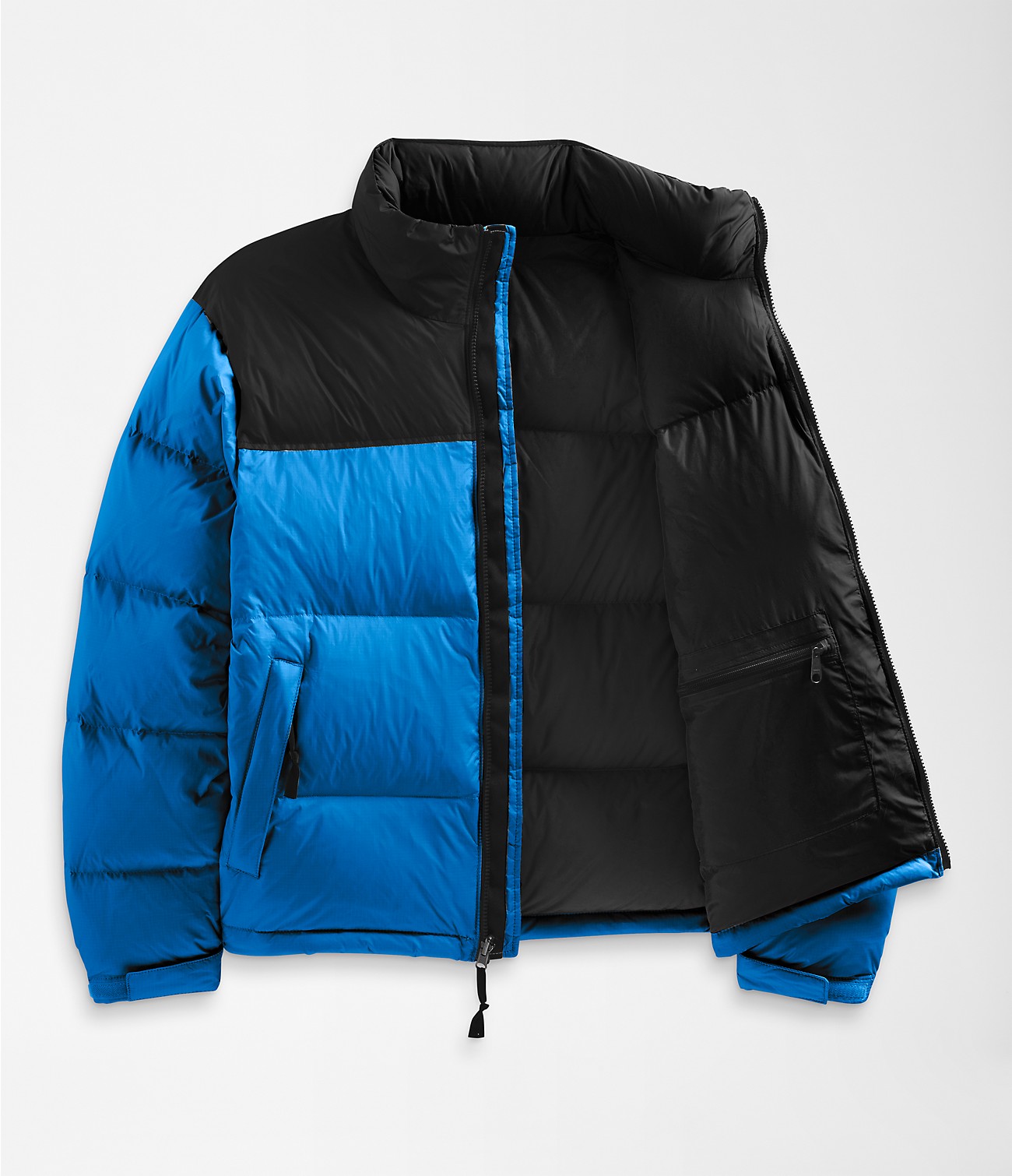
1996 Retro Nuptse Jacket by The North Face
Our rating: ★★★★★
Price: $$$$
Warmth and durability meet timeless style.
What makes it special? Its oversized baffles and boxy silhouette are inspired by the brand's iconic 1996 Nuptse Jacket, making it a classic and timeless piece. What sets this jacket apart from its competitors is the use of 100% recycled fabrics, making it an eco-friendly choice for the conscious consumer. Additionally, the non-PFC DWR finish adds water repellency, ensuring that you stay warm and dry no matter what the weather is like. The 700-fill goose down provides optimal warmth while remaining compressible, making it easy to pack for outdoor adventures. The stowable hood, exposed VISLON® center front zip, and secure-zip hand pockets make this jacket practical and functional, while the encased-elastic cuffs with adjustable hook-and-loop cuff tabs and Triclimate® loops for snap-in compatibility with the GTX Mountain Jacket adds versatility. Plus, with its oversized logos and taffeta overlay, it's sure to make a statement wherever you go.
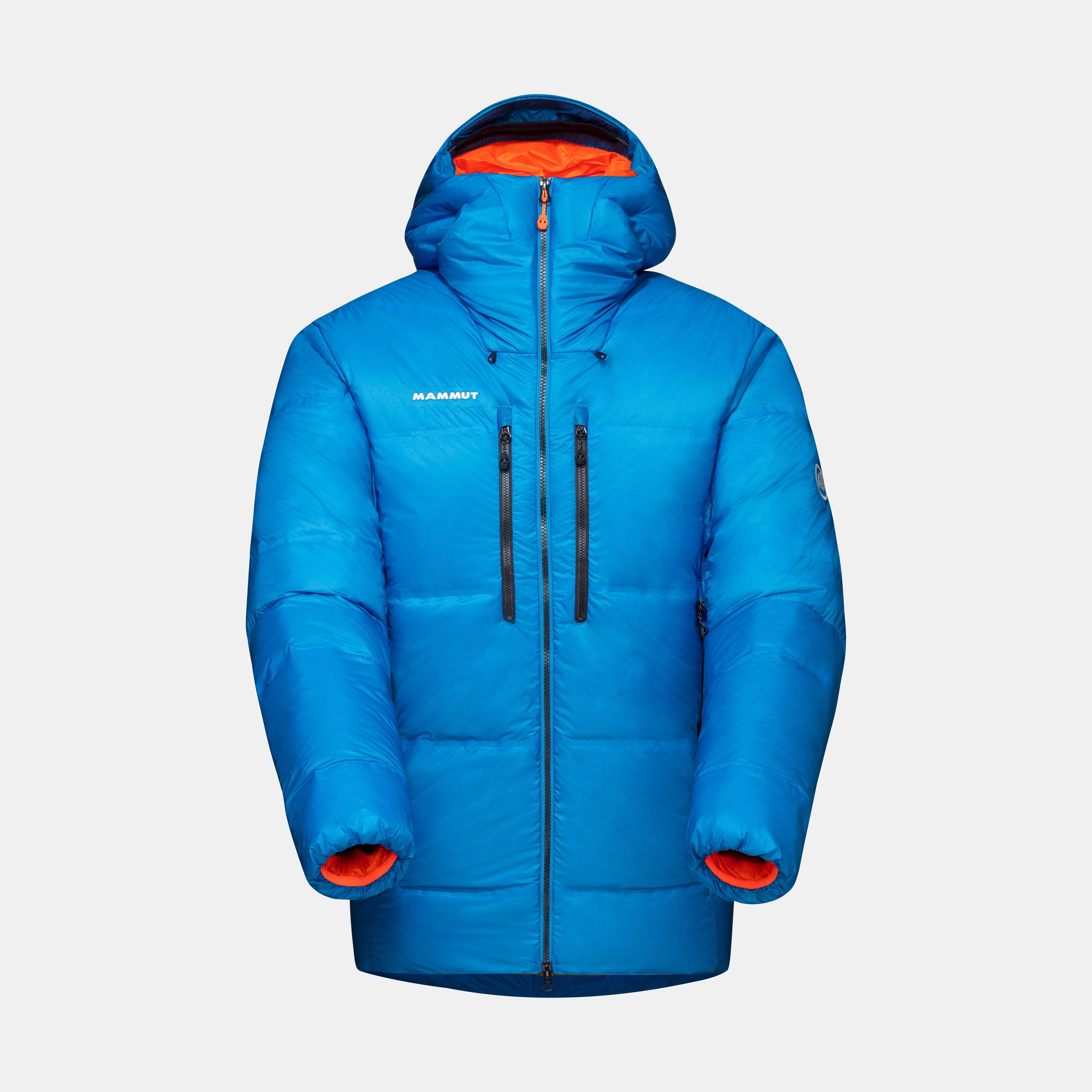
Eigerjoch Pro IN Hooded Jacket by Mammut
Our rating: ★★★★★
Price: $$$$+
Ultimate protection for extreme cold conditions.
What makes it special? This jacket is perfect for mountain expeditions, winter bivouacking, or belaying on ice climbs. Its ultra-light and abrasion-resistant Pertex® Quantum Pro material, coupled with a water-repellant treatment, offers superior protection against extreme weather conditions. The double chamber construction, partially taped seams, and water-repellant down treated with PrimaLoft™ synthetic fiber insulation make sure you stay warm and dry in the harshest conditions. The Eigerjoch Pro IN Hooded Jacket is also equipped with many convenient features like backpack-compatible pockets, wrist gaiters, and a separate stuff sack with carabiner loops. The MAMMUT High Reach Technology™ ensures unrestricted freedom of movement when climbing. The one-hand adjustable drawstring cord with Cohaesive® stoppers allows easy adjustment of the hood and hem, even when wearing gloves. This jacket contains non-textile parts of animal origin (down or leather) and filled with 200 g water-repellent 90/10 goose down for optimal heat retention. Its innovative features and clever design make it unique in its class.
North Face Vs Mammut Men's Lightweight Insulated Jackets
When it comes to men's lightweight insulated jackets, both The North Face and Mammut offer top-quality options that are sure to keep you warm and comfortable during outdoor adventures.
The North Face's ThermoBall™ Eco Jacket 2.0 is a great option for those looking for a jacket that is both eco-friendly and durable. Made with 100% recycled fabrics and fill, this jacket is not only kind to the planet but also to your body, thanks to its innovative quilting pattern and advanced insulation. Its slim fit and packable design make it a great choice for both outerwear and mid-layering.
On the other hand, Mammut's Eigerjoch Advanced IN Hooded Jacket is a well-insulated jacket with a combination of premium goose down and synthetic PrimaLoft Gold Insulation Active that gives you the perfect balance of warmth and moisture-wicking. This jacket also features a helmet-compatible hood, reinforced peak, and a variety of pockets, making it a great option for mountaineering adventures.
In terms of durability, both brands offer excellent options. The North Face's ThermoBall™ Eco Jacket 2.0 uses an abrasion-resistant outer material, while Mammut's Eigerjoch Advanced IN Hooded Jacket comes with an extra abrasion-resistant Pertex® Quantum outer material that makes sure your jacket doesn't get damaged even in the roughest of terrain.
When it comes to deciding between the two brands, it really comes down to personal preference. If eco-friendliness is important to you, The North Face's ThermoBall™ Eco Jacket 2.0 is a great option. If you are looking for a well-insulated jacket that can handle mountaineering adventures, then Mammut's Eigerjoch Advanced IN Hooded Jacket is definitely worth considering.
At the end of the day, both brands offer top-quality options for men's lightweight insulated jackets. So, whether you choose to go with The North Face or Mammut, you can rest assured that you will be getting a reliable and durable jacket that will keep you warm and comfortable during your outdoor adventures.

ThermoBall™ Eco Jacket 2.0 by The North Face
Our rating: ★★★★★
Price: $$$$
Eco-friendly warmth and style for the outdoors.
What makes it special? This jacket is the perfect option for those looking for a lightweight, insulated jacket that is both durable and packable. The North Face is a brand known for producing high-quality outdoor gear that will stand up to even the harshest conditions. This jacket is no exception. With its innovative quilting pattern and advanced insulation, the ThermoBall™ Eco Jacket 2.0 provides lightweight warmth that is hard to beat. This jacket is also made with 100% recycled fabrics and fill, making it an eco-friendly option for those looking to reduce their impact on the environment. With its slim fit and 2.5x2.5 quilt pattern, the ThermoBall™ Eco Jacket 2.0 is both stylish and functional. The reverse-coil center front zip, stows in chest pocket, and concealed, secure-zip hand pockets make it the perfect option for those who want to keep their valuables safe and secure while on the go.
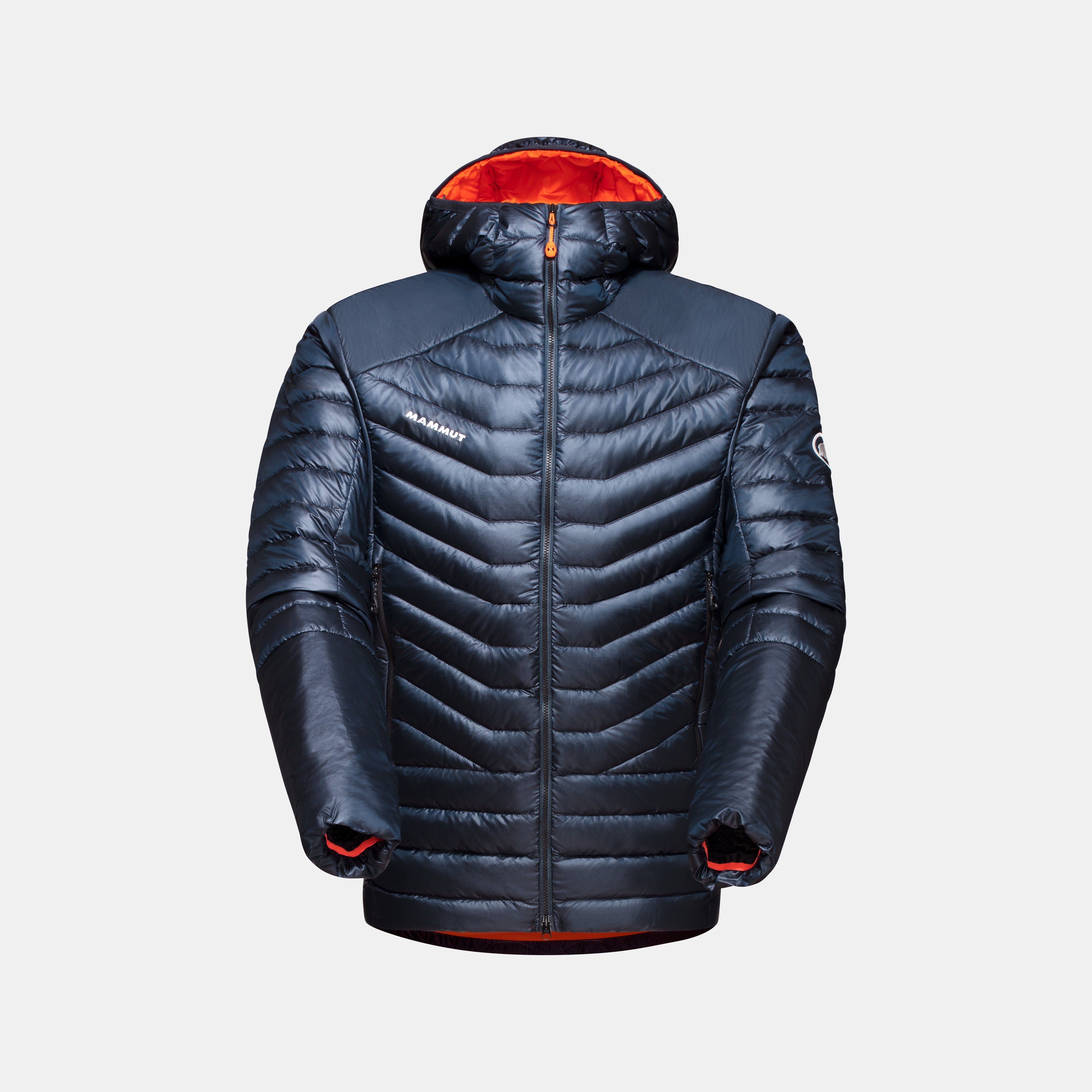
Eigerjoch Advanced IN Hooded Jacket by Mammut
Our rating: ★★★★★
Price: $$$$
The Perfect Blend of Warmth and Flexibility.
What makes it special? The Eigerjoch Advanced really stands out when it comes to its insulation technology. The combination of premium goose down and synthetic PrimaLoft Gold Insulation Active gives you the best of both worlds, keeping you warm and dry regardless of the weather conditions. It also makes sure that the areas where you sweat the most don't get soaked, keeping you warm and comfortable even during aerobic stages. The durability of this jacket is also impressive. The Pertex Quantum outer material is abrasion-resistant, making sure that your jacket doesn't get damaged even in the roughest of terrain. The jacket also comes with a helmet-compatible hood and reinforced peak, giving you an extra layer of protection for your head. Pockets are always a great feature with any jacket, and the Eigerjoch Advanced definitely doesn't disappoint. It has two front pockets that are climbing-harness-compatible, which is great for easy access to your essentials while you climb. The jacket can also be stowed in its front right pocket, making it easy to pack and carry. The YKK Vislon 2-way zipper is another highlight of this jacket. It's smooth and easy to operate, making sure that you don't get stuck while trying to zip up your jacket. It's perfect for those looking for a well-insulated, durable jacket that also offers great flexibility and mobility.
North Face Vs Mammut Men's Rain Jackets
The North Face and Mammut are both well-known in the outdoor gear industry for their high-quality men's rain jackets, and it can be tough to decide between the two. The North Face's Dryzzle FUTURELIGHT™ Jacket and Mammut's Crater HS Hooded Jacket are both excellent examples of what these brands have to offer, and comparing them can help you make an informed decision.
The Dryzzle FUTURELIGHT™ Jacket is a stylish and practical option for anyone seeking a top-quality rain jacket. Its slim fit and breathable-waterproof technology ensure you stay dry while allowing your body to breathe and regulate its temperature. It also features plenty of practical features, including three zip-secure pockets, an adjustable hood, and hook-and-loop cuff tabs. And as an eco-friendly choice made from recycled polyester and nylon, it's perfect for anyone who wants to minimize their environmental impact.
On the other hand, Mammut's Crater HS Hooded Jacket is designed specifically for alpine adventures. It features a triple-layer hardshell with a waterproof GORE-TEX membrane, making it ideal for staying dry in heavy rain and snow. The stormproof, helmet-compatible hood and underarm ventilation zippers also make it easy to stay comfortable and protected in any weather conditions. And with the innovative Georganic 3D Technology T Shape Pattern, it's optimized for a perfect fit and maximum freedom of movement.
Both The North Face and Mammut offer excellent options in terms of men's rain jackets, so your choice may come down to your specific needs. The Dryzzle FUTURELIGHT™ Jacket is a great all-rounder that's perfect for everyday use, while the Crater HS Hooded Jacket is designed specifically for alpine adventures and offers exceptional protection and comfort in the harshest conditions. So whether you're looking for a reliable everyday rain jacket or an adventure-ready hardshell, these two brands have you covered.
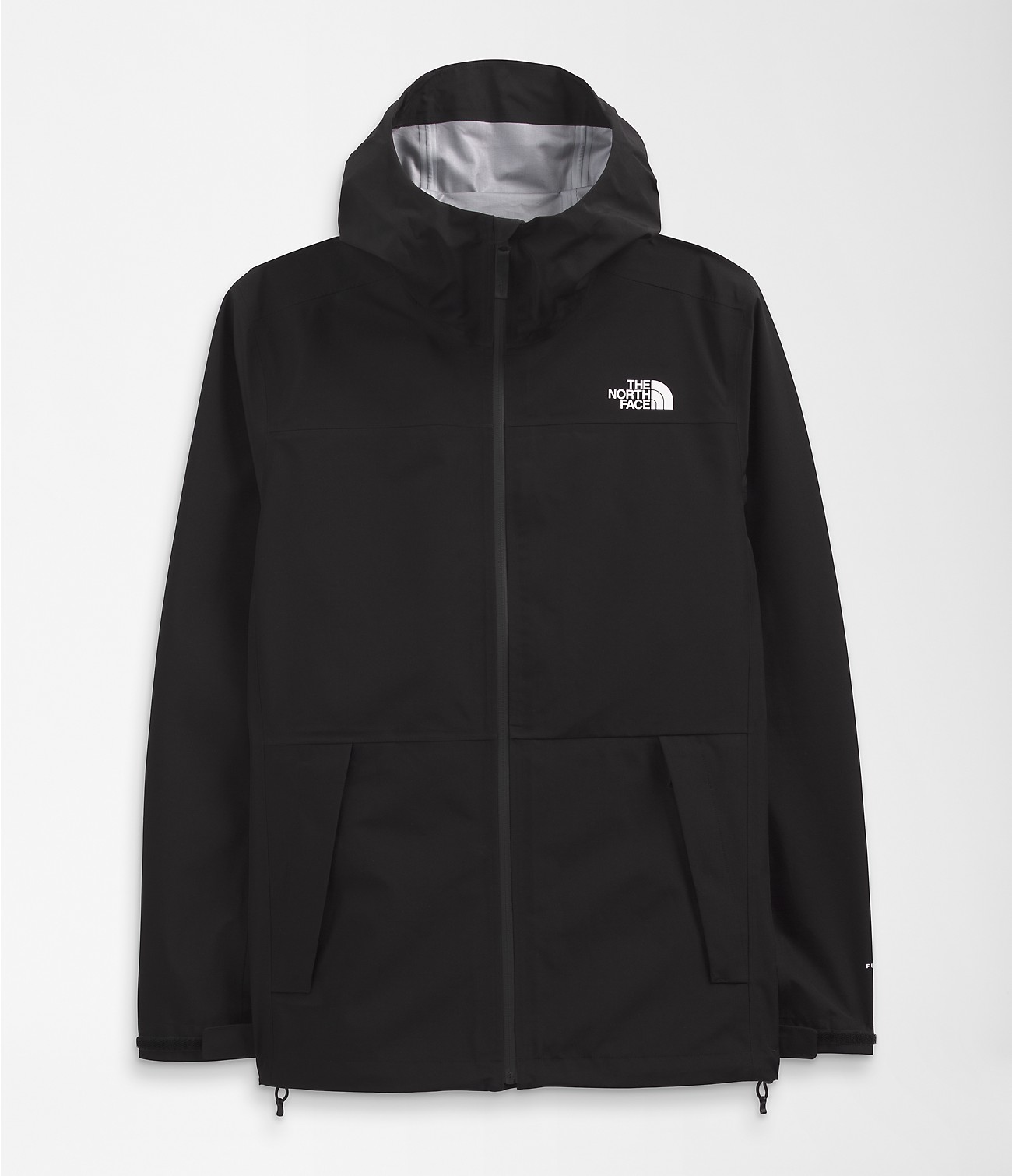
Dryzzle FUTURELIGHT™ Jacket by The North Face
Our rating: ★★★★★
Price: $$$$
Stylish and practical rain jacket for men.
What makes it special? With its slim fit design, it's a stylish and practical choice for any rainy day. One of the stand-out features of this jacket is its breathable-waterproof technology, which ensures you stay dry even in heavy rain, while allowing your body to breathe and regulate its temperature. The shell is made from a soft stretch-woven face and stretch-knit backer, which provides both warmth and comfort. In terms of practical features, there are three zip-secure pockets, including an internal stow pocket, giving you plenty of space to store your essentials. The adjustable hood offers a great level of flexibility, while the hook-and-loop cuff tabs and internal hem cinch-cord allow you to find the perfect fit. The Dryzzle FUTURELIGHT™ Jacket is also eco-friendly, with a non-PFC DWR finish and a body made from recycled polyester and nylon.
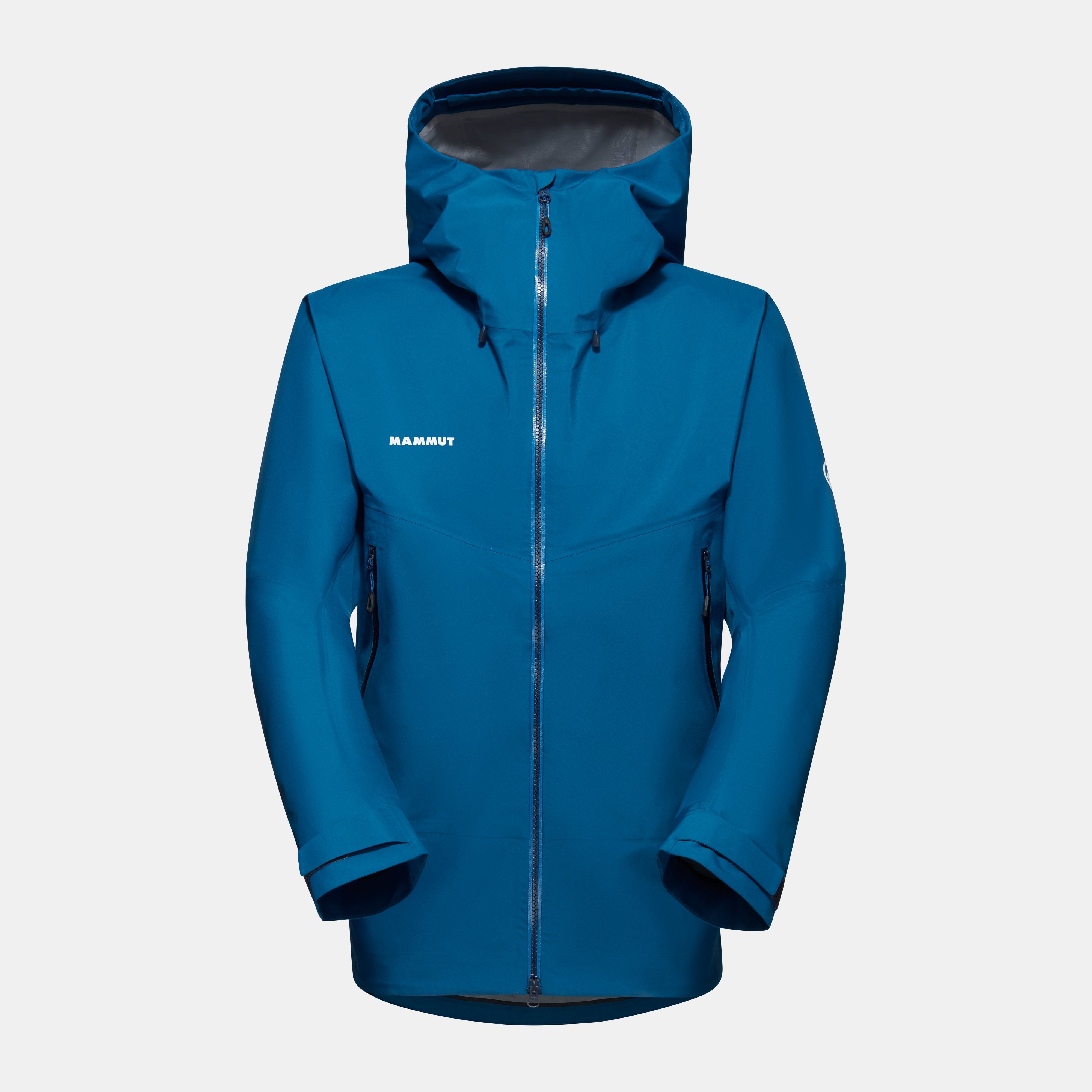
Crater HS Hooded Jacket by Mammut
Our rating: ★★★★★
Price: $$$$
The ultimate must-have for alpine explorers.
What makes it special? This jacket is the ultimate must-have on the mountain, and it's equipped with so many smart features that you'll wonder how you ever managed without it. Designed with the needs of the alpine explorer in mind, the Crater HS Hooded Jacket boasts a helmet-compatible hood, zippers for underarm ventilation, and cleverly positioned pockets that offer easy access even with a harness on. The stormproof, vertically and horizontally adjustable hood even comes with a reinforced shield for an optimum field of vision at all times and easy operation when wearing gloves. The Crater HS Hooded Jacket is crafted from a triple-layer hardshell with a waterproof GORE-TEX membrane, so you'll stay dry no matter how wet the weather gets. Plus, it features Mammut's innovative Georganic 3D Technology T Shape Pattern for an optimized fit and maximum freedom of movement. Whether you're scaling a mountain or just going for a hike, this jacket will keep you comfortable and protected. And if you're concerned about the environmental impact of your gear, you'll be pleased to know that the Crater HS Hooded Jacket features a solution-dyed backer for more sustainable production through significantly reduced water consumption. With two climbing harness-compatible front pockets, a zippered inner pocket, pre-shaped sleeves with hook and loop fastener, and a hem drawstring that can be adjusted with one hand, the Crater HS Hooded Jacket is a true all-rounder that's perfect for any adventure.
North Face Vs Mammut Men's Ski Jackets
If you're in the market for a new men's ski jacket and can't decide between The North Face and Mammut, let's take a closer look at each brand's offerings. The North Face's ThermoBall™ Eco Snow Triclimate® Jacket and Mammut's Stoney HS Thermo Jacket are both excellent options, but they have different features that might suit your needs better.
Starting with The North Face, their ThermoBall™ Eco Snow Triclimate® Jacket is a versatile option that can keep you warm and dry on the slopes. The jacket has a waterproof and breathable DryVent™ 2L shell, an attached helmet-compatible hood, and underarm vents to keep you comfortable and dry. It also comes with 11 g/ft² ThermoBall™ Eco insulation for warmth even in wet weather. Plus, it's zip-in compatible with other garments from The North Face, allowing you to customize your layering for the ultimate warmth and comfort.
Moving on to Mammut, their Stoney HS Thermo Jacket is another high-performance jacket that can provide maximum protection and insulation on cold and wet days. The jacket is made with 2-layer DRYtech™ material, which can keep out snow and rain while remaining breathable, making it perfect for both active and leisurely skiing. The synthetic Ajungilak® OTI™ insulating fibers are impervious to moisture, keeping you warm and dry even on the coldest and wettest days. Additionally, this jacket has a range of pockets, including water-repellent zippers and a wrist pocket for a ski pass. It also has underarm ventilation with a water-resistant 2-way zipper, which allows for maximum breathability and comfort.
When comparing these two brands, one thing to keep in mind is your individual needs. If you prioritize versatility and layering options, The North Face's ThermoBall™ Eco Snow Triclimate® Jacket might be the better choice for you. However, if you prioritize weather protection and insulation, Mammut's Stoney HS Thermo Jacket might suit you better.
In conclusion, both The North Face and Mammut offer high-quality men's ski jackets with unique features and benefits. Whether you choose The North Face's ThermoBall™ Eco Snow Triclimate® Jacket or Mammut's Stoney HS Thermo Jacket ultimately comes down to your individual preferences and needs as a skier.
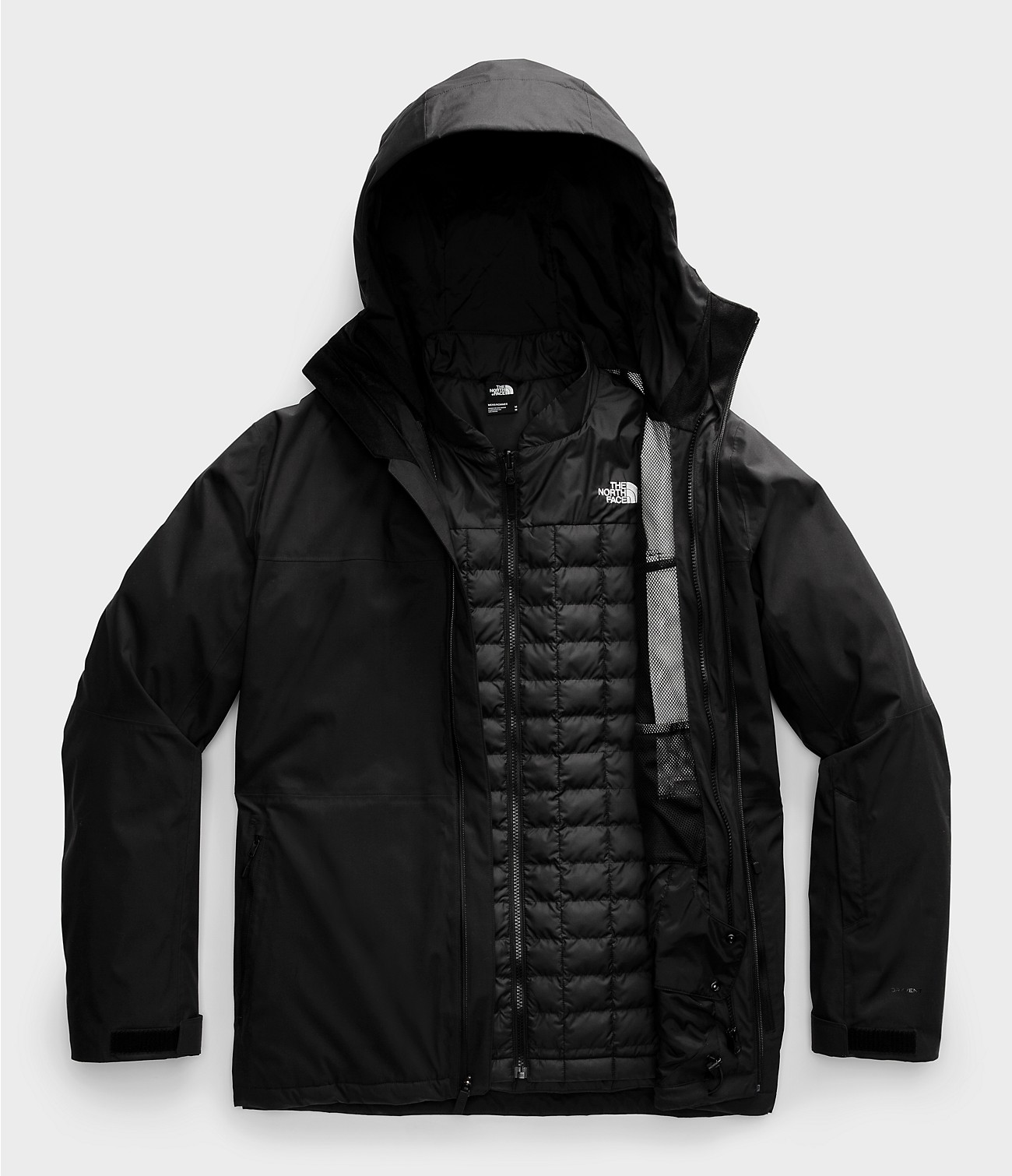
ThermoBall™ Eco Snow Triclimate® Jacket by The North Face
Our rating: ★★★★★
Price: $$$$
Stay warm and dry all day on the mountain.
What makes it special? This jacket has all the features you need for a full day on the mountain and the versatility to take you from skiing straight to après. With a waterproof and breathable DryVent™ 2L shell, you'll stay dry even on the wettest days. The non-PFC DWR finish adds an extra layer of protection against the elements. The jacket also comes with an attached, helmet-compatible hood, secure-zip pockets, an internal goggle pocket, and underarm vents to keep you comfortable no matter the conditions. But what really sets this jacket apart is its 11 g/ft² ThermoBall™ Eco insulation. The innovative insulation technology provides warmth even in wet weather, making it a great option for those unpredictable ski days. Plus, the ThermoBall™ Eco Snow Triclimate® Jacket is zip-in compatible with other garments from The North Face® so you can customize your layering for the ultimate warmth and comfort. With its features and insulation, this jacket will keep you warm and dry all day long on the mountain.
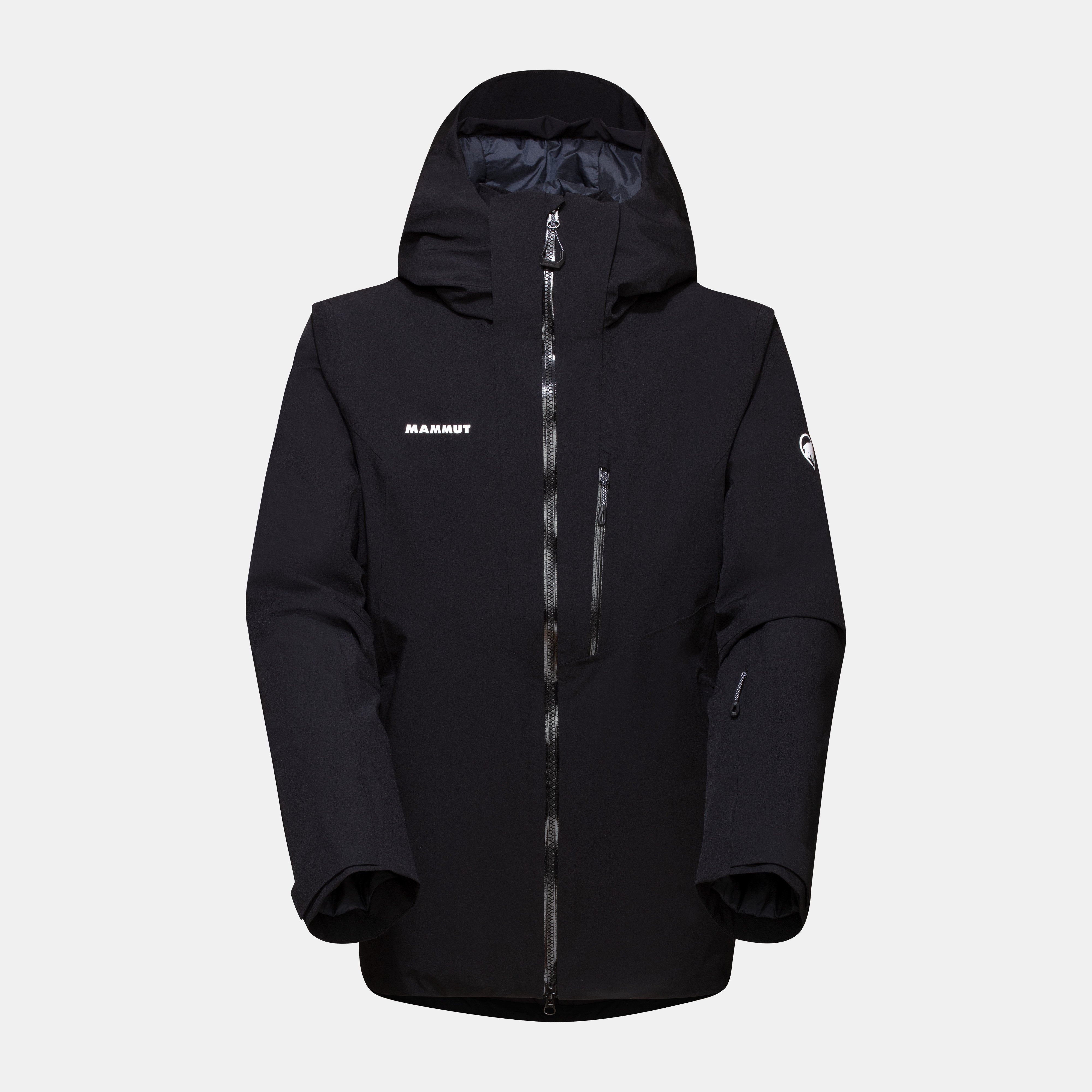
Stoney HS Thermo Jacket by Mammut
Our rating: ★★★★★
Price: $$$$
Ultimate protection and insulation for your snowy adventures.
What makes it special? Made with 2-layer DRYtech™ material, this jacket can keep out snow and rain while remaining breathable, making it perfect for both active and leisurely skiing. One of the features that stands out is its detachable, three-way-adjustable hood, which can be adjusted for a customized fit that ensures maximum protection against the elements. Additionally, the jacket is filled with 80 g/m² Ajungilak® OTI™ Element on the body and 60 g/m² Ajungilak OTI™ Element on the arms and collar, which can keep you warm and dry even on the coldest and wettest days. The synthetic material is also impervious to moisture, which means you don't have to worry about getting wet during your skiing adventure. The Mammut Stoney HS Thermo Jacket also comes with a range of pockets, including a chest pocket with a water-repellent zipper and two side pockets with water-repellent zippers. It also has an internal pocket made from elastic mesh material and a wrist pocket for a ski pass, ensuring that your essentials are always within reach. Additionally, the jacket has underarm ventilation with a water-resistant 2-way zipper, which allows for maximum breathability and comfort. The jacket features a pre-shaped sleeve with hook and loop fasteners and wrist gaiters, which provide additional warmth and protection against the cold. Moreover, the Mammut Stoney HS Thermo Jacket has a zip-off snow skirt with anti-slip grip and double button placket for individual adjustment, which can ensure that the jacket stays in place when you're skiing. The snap buttons on the snow skirt also allow you to attach the jacket to pants, creating a more streamlined appearance.
North Face Vs Mammut Women's Down Parkas
When it comes to high-quality women's down parkas, both The North Face and Mammut offer excellent options. While the Arctic Parka from The North Face and the Fedoz IN Hooded Parka from Mammut share some similarities, there are also distinct differences between the two.
First, let's talk about The North Face's Arctic Parka. This parka features a waterproof, breathable DryVent™ 2L shell and 550-fill goose down throughout the body for maximum warmth. It also features 150g Heatseeker™ Eco in the side panels, creating a beautiful, flattering fit without sacrificing its warmth-to-weight ratio. The Arctic Parka's stormflap with a hook-and-loop closure that covers the two-way, VISLON® center front zip ensures that you stay dry no matter what the elements throw your way. On the other hand, Mammut's Fedoz IN Hooded Parka is made of extremely soft and lightweight Pertex® Quantum material that's also wind- and water-repellent. Its 150g 90/10 duck down filling with 750 cuin fill power provides excellent insulation, and its extra-long cut ensures that the legs stay warm too.
While both parkas have their unique strengths, the Arctic Parka by The North Face has some additional features that make it stand out. For example, it includes secure-zip, internal media-compatible pockets and covered, secure-zip, welt hand pockets, which are both useful for storing your essentials while on the go. The Fedoz IN Hooded Parka by Mammut, on the other hand, comes with microfleece-lined side pockets, which are an excellent addition for those looking to keep their hands warm.
Ultimately, the decision between these two brands will come down to personal preference and what features are most important for your needs. The North Face's Arctic Parka is an excellent option for those looking for a down parka that's both stylish and functional, with a flattering fit and waterproof technology that can withstand even the harshest winter conditions. Meanwhile, Mammut's Fedoz IN Hooded Parka is perfect for those wanting a parka that's lightweight, eco-friendly, and also wind- and water-repellent.
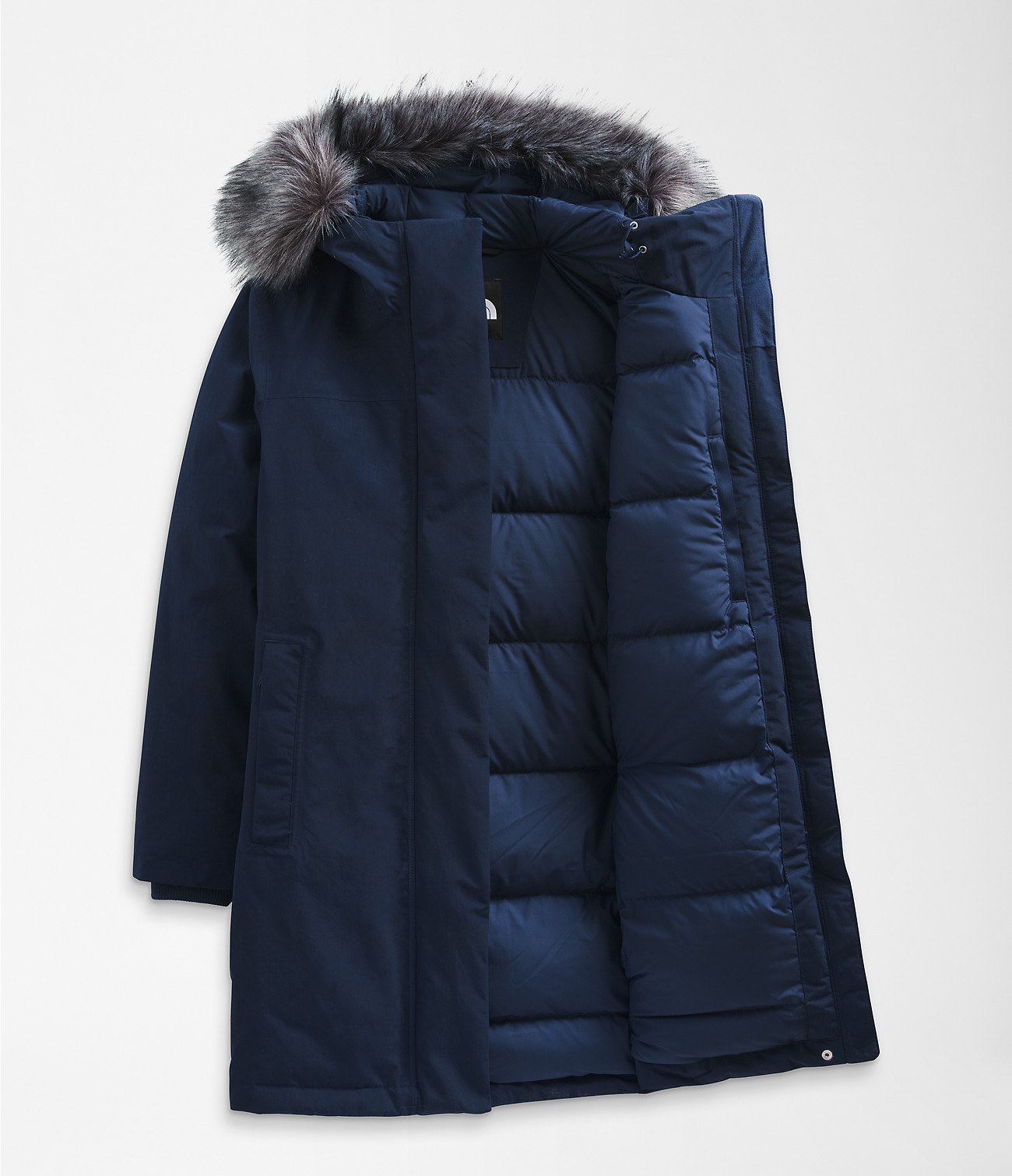
Arctic Parka by The North Face
Our rating: ★★★★★
Price: $$$$
Stay warm all winter long with this down parka.
What makes it special? This parka is the perfect combination of style and functionality, with its waterproof, breathable DryVent™ 2L shell and 550-fill goose down throughout the body for maximum warmth. It also features 150g Heatseeker™ Eco in the side panels, creating a beautiful, flattering fit without sacrificing its warmth-to-weight ratio. The Arctic Parka also includes a stormflap with a hook-and-loop closure that covers the two-way, VISLON® center front zip, ensuring that you stay dry no matter what the elements throw at you. Covered, secure-zip, welt hand pockets are perfect for storing your essentials, and there's also a secure-zip, internal media-compatible pocket, so you can listen to your favorite tunes on the go. The rib-knit cuffs add an extra layer of warmth, while the embroidered logo on the left chest and back-right shoulder adds a touch of style to this already classy parka. With its internal, secure-zip pocket at the left chest, you won't have to worry about losing any of your valuables.
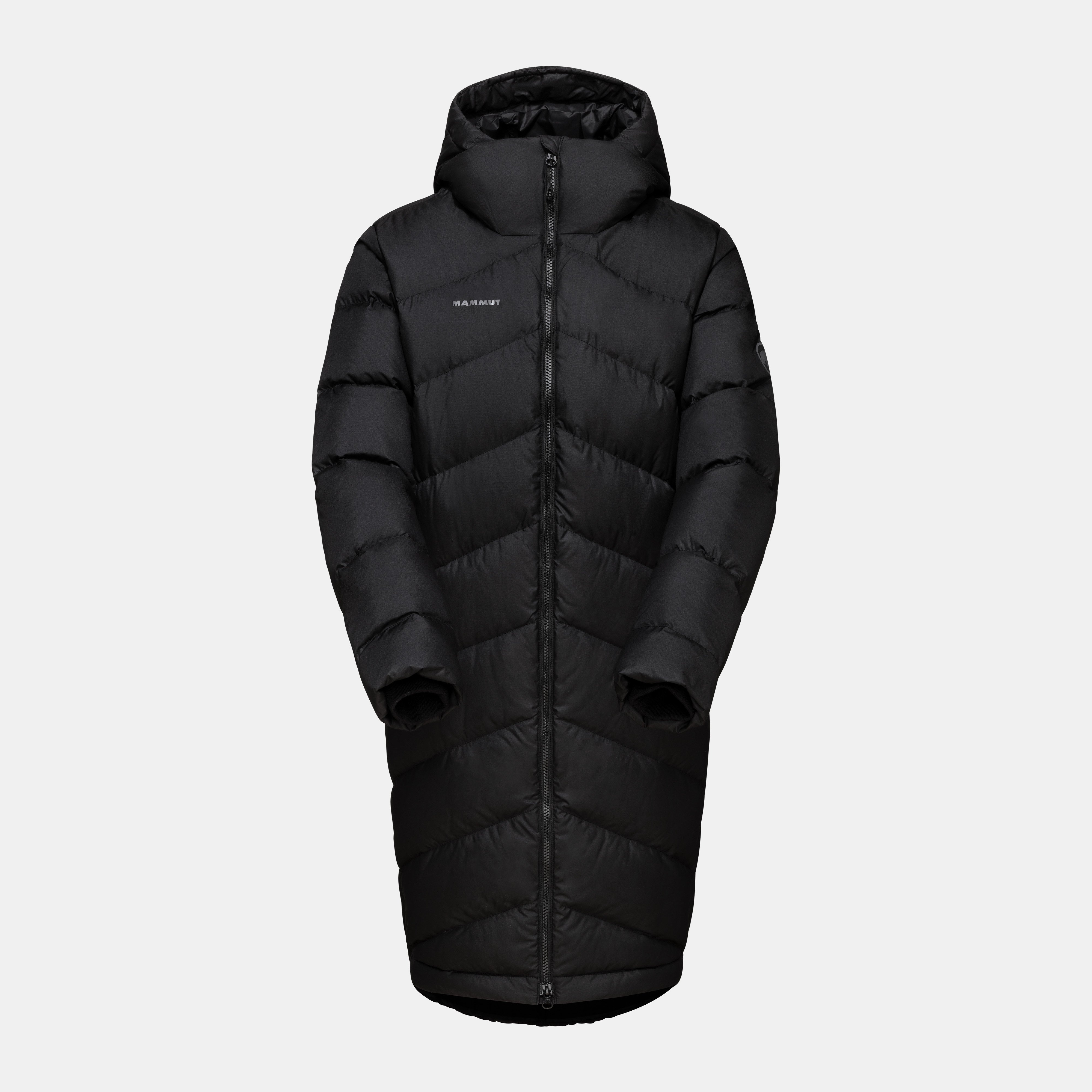
Fedoz IN Hooded Parka by Mammut
Our rating: ★★★★★
Price: $$$$
Stay warm and stylish this winter with this eco-conscious parka.
What makes it special? This parka is designed specifically with women in mind, and its stylish silhouette sets it apart from the competition. Its recycled Pertex® Quantum outer material is both soft and durable, making it an excellent choice for those who want a coat that will last for multiple winters. The added bonus of being wind- and water-repellent means that the wearer can stay dry and warm even in the harshest weather conditions. One of the highlights of this parka is the 150g 90/10 duck down filling with 750 cuin fill power. This ensures that the wearer stays cozy and insulated during cold winter days. The extra-long cut of the parka also means that the legs are kept warm, which is often a problem with shorter winter coats. The Fedoz Hooded Parka is also equipped with an array of useful features, such as an adjustable hood, multiple pockets both inside and out, and wide-ribbed cuffs. The side slit on the hem adds to the coat's functionality by providing greater freedom of movement.
North Face Vs Mammut Women's Lightweight Insulated Jackets
In the great debate between North Face vs Mammut when it comes to women's lightweight insulated jackets, it all comes down to your individual needs and preferences, but both brands have a lot to offer.
Let's start with The North Face's ThermoBall Eco Hoodie 2.0, which boasts a slim-fit, innovative 2x2 quilt pattern, ThermoBall Eco insulation, and concealed, secure-zip hand pockets. What sets this jacket apart is its use of 100% recycled fabrics and fill in the manufacturing process, making it a sustainable option that's kinder to the environment.
On the other hand, Mammut offers the Eigerjoch Advanced IN Hooded Jacket, featuring a blend of two types of insulation: premium water-repellant goose down and soft, stretchy PrimaLoft Gold Insulation Active synthetic fiber material. This jacket is also made from ultra-lightweight, water-repellent Pertex® Quantum material with Diamond Fuse technology for superb abrasion resistance, making it durable and versatile for a wide range of mountaineering activities.
Both jackets have their unique strengths, with The North Face's sustainable materials being a key selling point, and Mammut's dual insulation technology and abrasion-resistant materials offering performance and versatility. It ultimately comes down to what you need, and which features are most important for your outdoor activities.

ThermoBall™ Eco Hoodie 2.0 by The North Face
Our rating: ★★★★★
Price: $$$$
Sustainable and Stylish Insulated Jacket.
What makes it special? This jacket is a game-changer with its slim-fit and innovative 2x2 quilt pattern that not only looks modern but also provides a durable and lightweight warmth that is perfect for outdoor adventures. What sets this jacket apart from other brands is the use of 100% recycled fabrics and fill in the manufacturing process, making it a sustainable and ethical choice. Not only is it kinder to the environment, but the recycled materials create a unique texture and color for each garment, making it a stylish and one-of-a-kind jacket. The ThermoBall™ Eco insulation technology ensures warmth, even when wet, and with its attached hood and reverse-coil center front zip, it offers extra protection against the elements. The jacket also has concealed, secure-zip hand pockets, allowing you to keep your essentials safe and close by. With its advanced insulation, sleek style, and eco-friendly materials, this jacket ticks all the boxes for a women's lightweight insulated jacket.
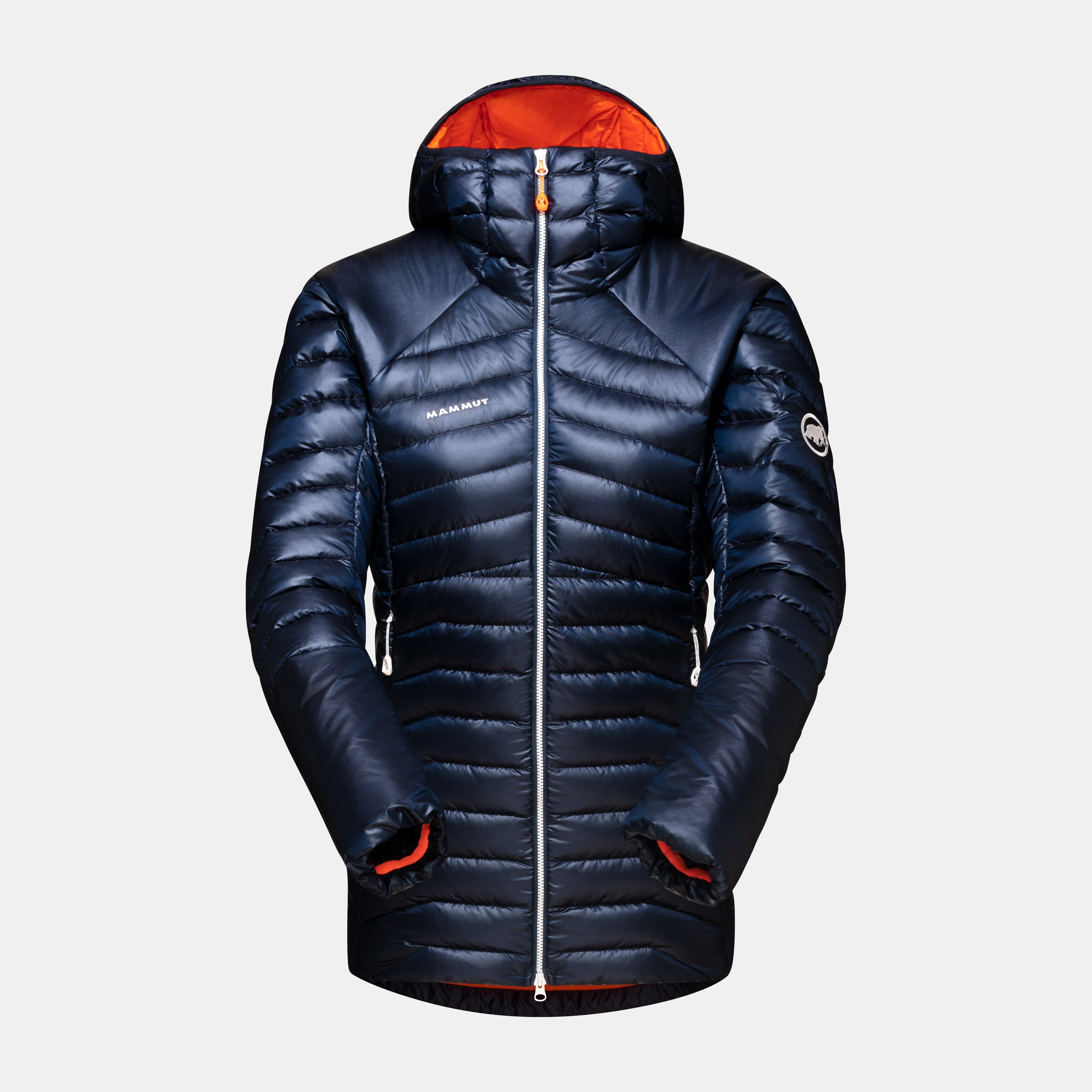
Eigerjoch Advanced IN Hooded Jacket by Mammut
Our rating: ★★★★★
Price: $$$$
Innovative Insulation for Mountaineering Adventures.
What makes it special? What sets this jacket apart is its blend of two types of insulation. The premium water-repellant goose down from Responsible Down Standard suppliers keeps your upper arms, core, and hood interior warm, while the soft, stretchy PrimaLoft® Gold Insulation Active™ synthetic fiber material used in high-perspiration areas keeps you warm even during more aerobic stages or when it's damp outside. Additionally, the jacket is made from ultra-lightweight, water-repellent Pertex® Quantum material with Diamond Fuse technology for superb abrasion resistance. This means it can hold up against scuffles with rock and heavy backpacks, making it a versatile jacket for a wide range of mountaineering adventures. Other features include a helmet-compatible hood with reinforced peak, zippered inner pocket, and two climbing-harness-compatible front pockets with zippers. And when you're not wearing the jacket, it can easily be stowed in the front right pocket thanks to its small packing volume.
North Face Vs Mammut Women's Rain Jackets
When it comes to women's rain jackets, there are many options on the market, but two standout brands are The North Face and Mammut. Let's take a closer look at each brand's offerings using the reviewed products as examples.
The North Face's Antora Jacket is a stylish and eco-friendly rain jacket that features 100% recycled fabric as well as waterproof, breathable, and seam-sealed DryVent™ 2L technology. Its design is alpine-style with secure-zip hand pockets, an attached three-piece hood with adjustable cord locks, and elastic-bound cuffs. While its features are sure to keep you dry and protected from the elements, they are still limited in comparison to the Mammut option.
Mammut's Convey Tour HS Hooded Jacket, on the other hand, features a GORE-TEX PACLITE® membrane, which provides excellent wind- and waterproofing while remaining breathable. Its adjustable hood, cuffs, and hem allow for a truly customizable fit, while zippered pockets, an underarm zipper for ventilation, and pre-shaped sleeves with hook and loop fasteners provide added functionality. Additionally, its highly compressible design ensures it's easy to pack and bring along on any adventure.
While both brands offer high-quality rain jackets, Mammut's Convey Tour HS Hooded Jacket has a more extensive feature set, making it the better choice for those looking for a more versatile and functional rain jacket. The North Face's Antora Jacket is a great option for those who want a stylish and eco-friendly option on a budget, but it does not offer the same level of functionality and convenience as the Convey Tour HS Hooded Jacket.
Ultimately, when deciding between the two brands, it's important to consider what features are most important to you. If you want a cheaper rain jacket that is eco-friendly and stylish with basic protection features, The North Face has you covered with their Antora Jacket. However, if you're looking for a rain jacket that's highly functional and loaded with features, look no further than the Mammut Convey Tour HS Hooded Jacket.

Antora Jacket by The North Face
Our rating: ★★★★★
Price: $$$$
Stay dry in style.
What makes it special? This jacket is perfect for adventurers who want to stay comfortable and stylish while out on the trails. One of the things that make this jacket stand out is its 100% recycled fabric. Not only are you staying dry, but you’re also doing your part for the environment. Additionally, the Antora Jacket is waterproof, breathable, and seam-sealed with a non-PFC DWR finish that keeps you dry in all-weather conditions. The alpine-style design with secure-zip hand pockets makes this jacket the perfect choice for those days where you need to keep your essentials safe and dry. The three-piece hood with a drawcord and cord locks for adjustability guarantees that your head will stay dry and secure during the rain, while the stormflap with hook-and-loop closure covers the center front zip for added protection against the elements. The Antora Jacket also features elastic-bound cuffs, an internal drawcord with a cord lock at hem for adjustability, and a drop-tail hem, ensuring you stay comfortable and protected in all weather conditions.

Convey Tour HS Hooded Jacket by Mammut
Our rating: ★★★★★
Price: $$$$
Unbeatable weather protection for adventurous women.
What makes it special? What sets this jacket apart is its use of GORE-TEX PACLITE® membrane, which provides excellent wind- and waterproofing without adding too much extra weight or bulk. This membrane is also highly breathable, ensuring that you stay comfortable during even intense hikes and rainstorms. Other notable features of the Convey Tour HS Hooded Jacket include its adjustable hood, cuffs, and hem, which help you customize the fit of the jacket to your liking and keep the elements out as much as possible. Additionally, this jacket has zippered pockets, an underarm zipper for ventilation, and pre-shaped sleeves with hook and loop fasteners for added mobility. It has all the features you need to stay comfortable and protected on your next hike, and its lightweight and compressible design makes it easy to pack and bring on any adventure.
North Face Vs Mammut Women's Ski Jackets
If you're in the market for a women's ski jacket, it can be tough deciding between The North Face and Mammut. Both brands offer a range of quality, high-performing jackets, but they each have their unique strengths.
The North Face Women's Superlu Jacket is a great option for those who prioritize functionality and versatility. Its waterproof, breathable DryVent™ 2L shell can handle all types of weather, and its Heatseeker™ Eco insulation keeps you warm even in wet conditions. Plus, its urban-inspired design adds a touch of style to your ski wear.
On the other hand, Mammut's Stoney HS Thermo Jacket is all about premium protection and comfort. Made from 2-layer DRYtech™ material with a water column of 20,000 mm, this jacket keeps out snow and rain while remaining breathable. Its synthetic Ajungilak® OTI™ insulating fibers provide unparalleled warmth and dryness, even on cold, wet days.
Both jackets have plenty of convenient features for skiers, including multiple pockets and adjustable cuffs and hems. The North Face Superlu Jacket also has underarm vents for ventilation, while the Mammut Stoney HS Thermo Jacket has wrist gaiters to keep snow out of your gloves. Ultimately, it comes down to what you prioritize in a ski jacket.
If you want a jacket that can handle any weather and offers a versatile design, go with The North Face Women's Superlu Jacket. But if you want a jacket that provides unbeatable protection and insulation, you can't go wrong with the Mammut Stoney HS Thermo Jacket. Whatever you choose, both brands offer quality ski jackets that will keep you comfortable and stylish on the slopes.
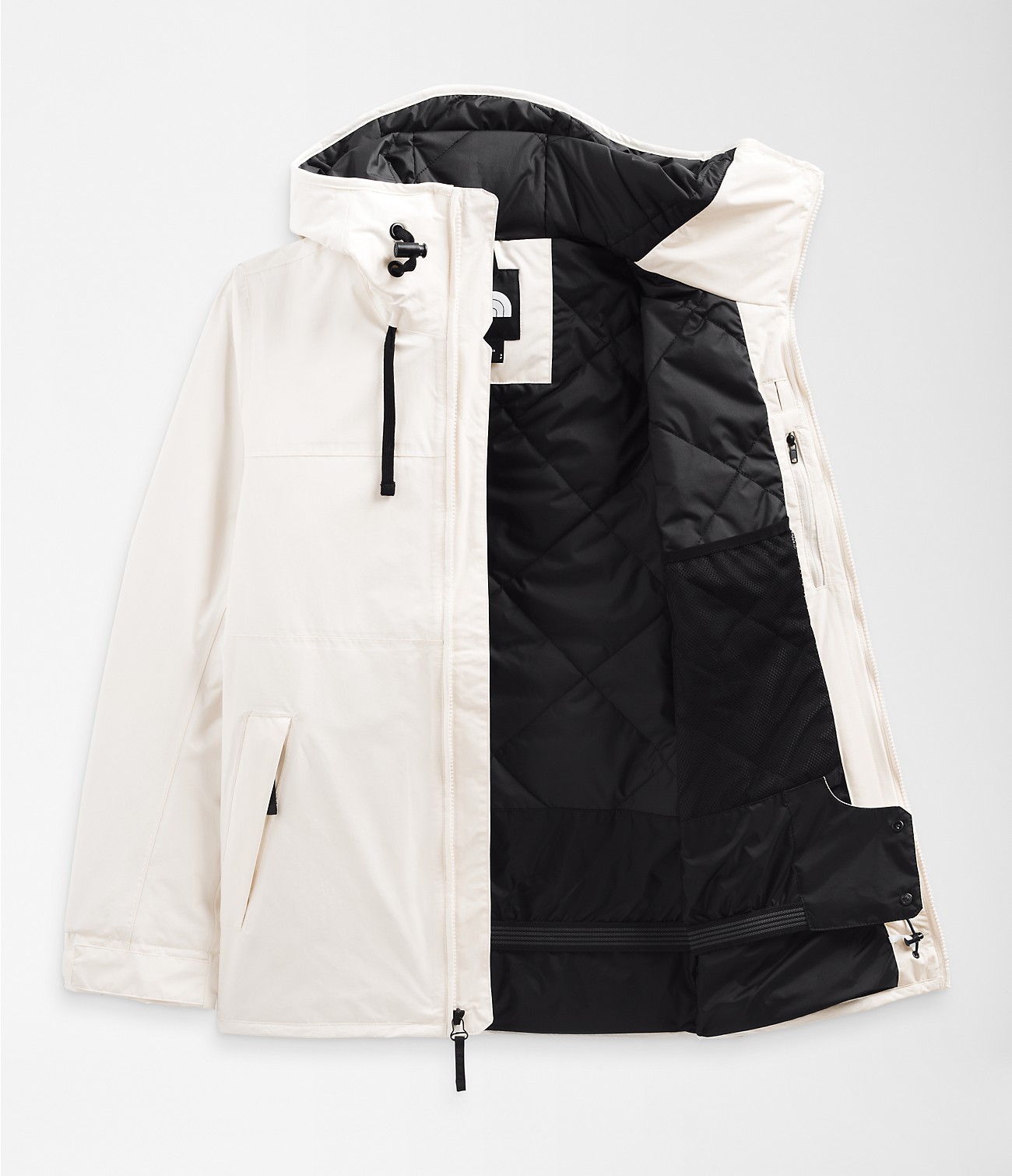
Superlu Jacket by The North Face
Our rating: ★★★★★
Price: $$$$
Stylish and functional ski jacket for women.
What makes it special? Its waterproof, breathable DryVent™ 2L shell will keep you warm and dry, from first chair until last. But the Superlu doesn't just prioritize functionality. Its urban-inspired design boasts a fixed hood, powder skirt, and an eye-catching embroidered logo on the left chest and back-right shoulder. Plus, the jacket features multiple secure-zip pockets, including a chest pocket with a media port and an internal goggle pocket. What really sets the Superlu apart, however, is its Heatseeker™ Eco insulation. Even in wet weather, the jacket's insulation keeps you warm and comfortable. And with adjustable cuffs and wrist pass pockets with secure hook-and-loop closures, the fit is completely customizable to your preferences. The Superlu outshines the competition with its multifaceted design and versatile functionality.
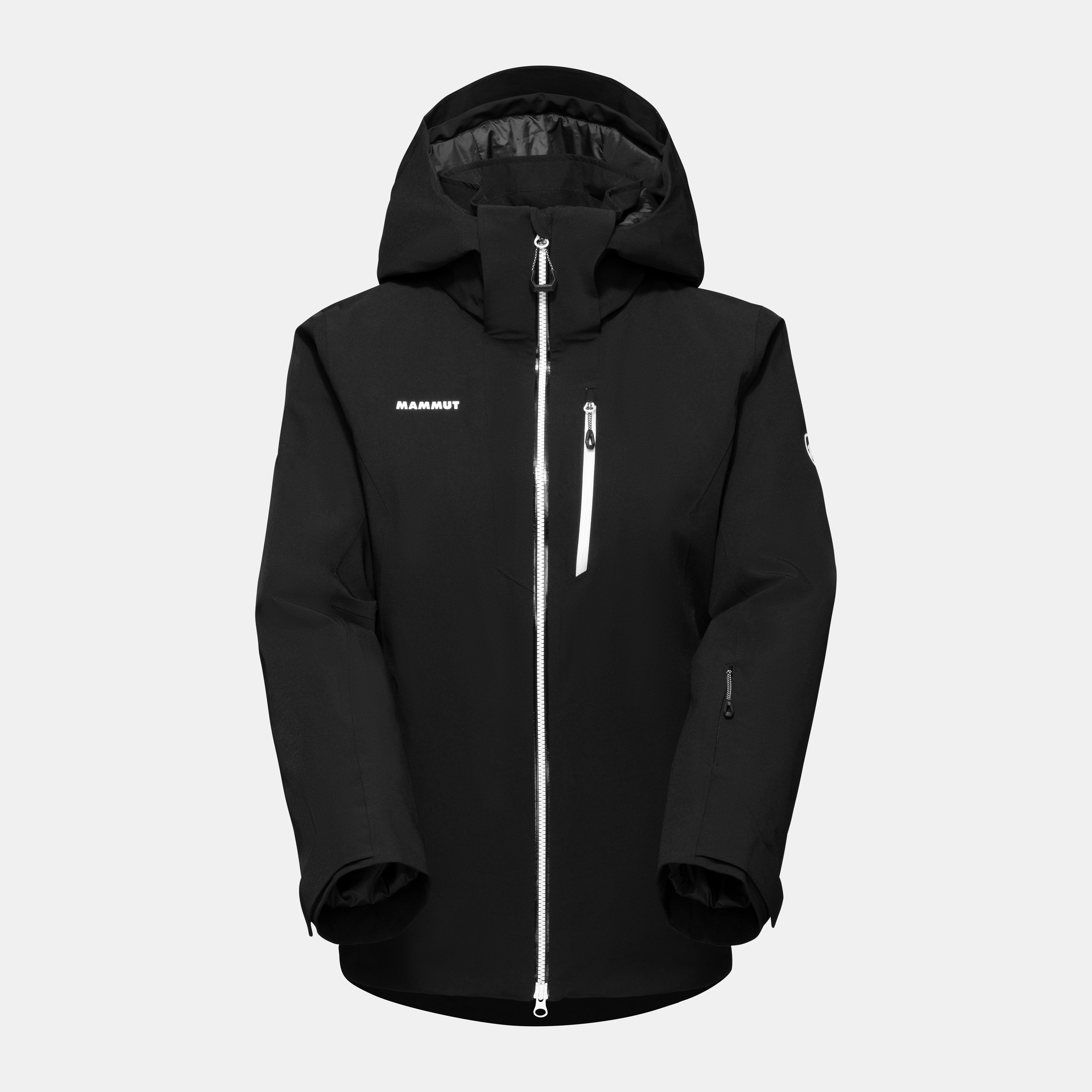
Stoney HS Thermo Jacket by Mammut
Our rating: ★★★★★
Price: $$$$
The ultimate weather protection and insulation for women skiers.
What makes it special? This women's ski jacket is the perfect combination of weather protection and insulation. Made from 2-layer DRYtech™ material with a water column of 20,000 mm, this jacket will keep you dry and comfortable all day long. The detachable, three-way-adjustable hood, concealed front zipper, and splash-proof side pockets provide complete weather protection. And with synthetic Ajungilak® OTI™ insulating fibers, you can stay warm and dry even on cold, wet days. But this jacket doesn't just offer protection from the elements. It also has plenty of convenient features for skiers. A chest pocket with a water repellent zipper, two zippered side pockets, a wrist pocket for a ski pass, and inner pockets provide plenty of storage. Pre-shaped sleeves with hook and loop fastener and wrist gaiters allow for a snug and comfortable fit. And the underarm ventilation with water-resistant 2-way zipper ensures that you won't overheat on those warmer days. The Stoney HS Thermo Jacket also has a zip-off snow skirt with an anti-slip grip and double button placket for individual adjustment, as well as snap buttons to attach the jacket to pants. And with an adjustable hem, you can customize the fit to your liking.
Final Verdict
After a thorough comparison of North Face and Mammut, it is clear that both brands offer excellent options in the world of coats and jackets. Each company has unique strengths and may appeal to different types of customers.
North Face is known for its durable and reliable outerwear, made for outdoor adventures and extreme weather conditions. On the other hand, Mammut prioritizes a sleek and stylish design while still providing protection from harsh elements.
Ultimately, the decision between North Face and Mammut depends on personal preference and what type of jacket or coat you are looking for. Both brands offer high-quality products that are well worth the investment.
So, don't get caught up in the idea of one brand being better than the other. Instead, focus on finding the perfect fit and style for you. With either North Face or Mammut, you will be sure to find a coat or jacket that will keep you warm and stylish for years to come.
Related articles
Helly Hansen vs North Face (The Definitive Guide)
North Face vs Arcteryx (The Definitive Guide)
North Face vs Fjallraven (The Definitive Guide)
Columbia vs North Face (The Definitive Guide)
Patagonia vs North Face (The Definitive Guide)
North Face vs Tommy Hilfiger (The Definitive Guide)
Nike vs North Face (The Definitive Guide)
Osprey vs North Face (The Definitive Guide)
Salomon vs North Face (The Definitive Guide)
Kathmandu vs North Face (The Definitive Guide)
Jack Wolfskin vs North Face (The Definitive Guide)
Marmot vs North Face (The Definitive Guide)
Canada Goose vs North Face (The Definitive Guide)
Eddie Bauer vs North Face (The Definitive Guide)
Uniqlo vs North Face (The Definitive Guide)
Mountain Hardwear vs North Face (The Definitive Guide)
Black Diamond vs North Face (The Definitive Guide)
Berghaus vs North Face (The Definitive Guide)
Carhartt vs North Face (The Definitive Guide)
Rei vs North Face (The Definitive Guide)
Merrell vs North Face (The Definitive Guide)
L.L. Bean vs North Face (The Definitive Guide)
Keen vs North Face (The Definitive Guide)
Timberland vs North Face (The Definitive Guide)
Dakine vs North Face (The Definitive Guide)
Haglofs vs North Face (The Definitive Guide)
Deuter vs North Face (The Definitive Guide)
Thule vs North Face (The Definitive Guide)
Karrimor vs North Face (The Definitive Guide)
Superdry vs North Face (The Definitive Guide)
Lululemon vs North Face (The Definitive Guide)
Craghoppers vs North Face (The Definitive Guide)
Stone Island vs North Face (The Definitive Guide)
Barbour vs North Face (The Definitive Guide)
Lands' End vs North Face (The Definitive Guide)
Moncler vs North Face (The Definitive Guide)
Adidas vs North Face (The Definitive Guide)
Montbell vs North Face (The Definitive Guide)
Oakley vs North Face (The Definitive Guide)
Kühl vs North Face (The Definitive Guide)
Napapijri vs North Face (The Definitive Guide)
Cotopaxi vs North Face (The Definitive Guide)
Decathlon vs North Face (The Definitive Guide)
Macpac vs North Face (The Definitive Guide)
Outdoor Research vs North Face (The Definitive Guide)
Spyder vs North Face (The Definitive Guide)
Herschel vs North Face (The Definitive Guide)
Eastpak vs North Face (The Definitive Guide)
Wantdo vs North Face (The Definitive Guide)
Hawke and Co vs North Face (The Definitive Guide)
Woolrich vs North Face (The Definitive Guide)
Geographical Norway vs North Face (The Definitive Guide)
Trespass vs North Face (The Definitive Guide)
Regatta vs North Face (The Definitive Guide)
Burton vs North Face (The Definitive Guide)
Mountain Equipment vs North Face (The Definitive Guide)
Obermeyer vs North Face (The Definitive Guide)
Point Zero vs North Face (The Definitive Guide)
Swiss Gear vs North Face (The Definitive Guide)
Mountain Warehouse vs North Face (The Definitive Guide)
Peak Performance vs North Face (The Definitive Guide)
North Face vs JanSport (The Definitive Guide)
North Face vs Aritzia (The Definitive Guide)
North Face vs Quecha (The Definitive Guide)
Mammut vs Arc'teryx (The Definitive Guide)
Patagonia vs Mammut (The Definitive Guide)
Marmot vs Mammut (The Definitive Guide)
Mammut vs Rab (The Definitive Guide)